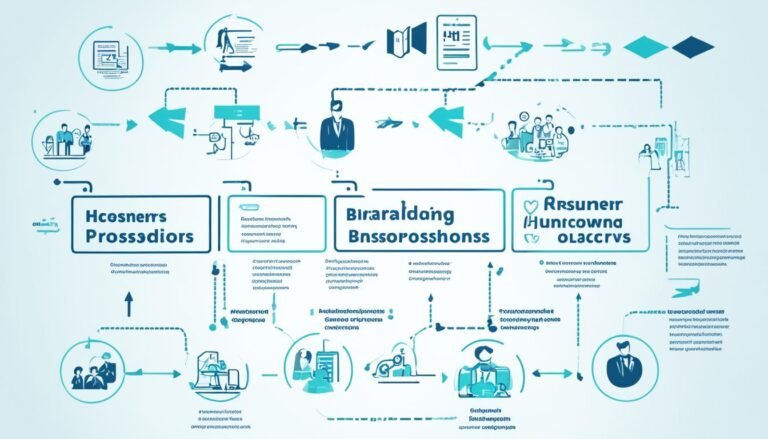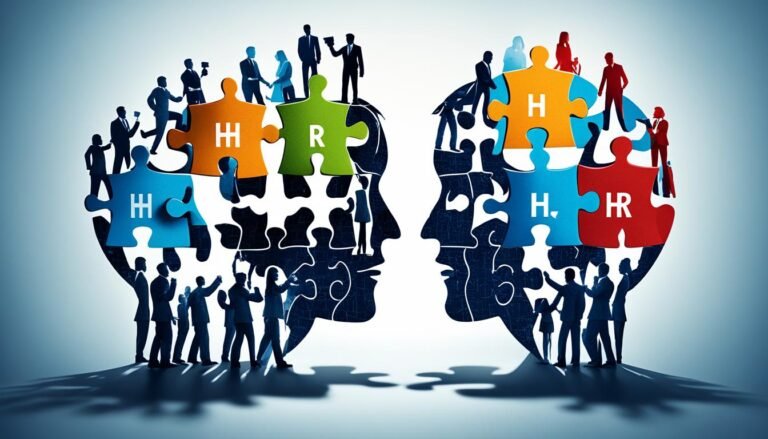A Guide to Human Resources Management Strategy
Strategic human resource management (SHRM) is a crucial aspect of organizational success. Businesses can effectively manage their employees by aligning HR programs and policies with the company’s business strategy. SHRM focuses on improving employee performance, developing the workforce, and creating a positive work environment. By strategically managing human capital, businesses can achieve optimal organizational growth.
Key Takeaways:
- Strategic human resource management (SHRM) aligns HR practices with the company’s business strategy.
- SHRM focuses on improving employee performance, developing the workforce, and creating a positive work environment.
- By aligning HR practices with the company’s goals, businesses can achieve optimal organizational growth.
- HR analytics is an essential tool for analyzing HR data and making informed strategic decisions.
- Effective SHRM practices contribute to improved employee engagement, reduced turnover, and increased productivity.
What is Strategic Human Resource Management?
Strategic Human Resource Management (SHRM) is the practice of creating policies and programs that align with the company’s business strategy. Unlike traditional HR management, which focuses on day-to-day tasks, SHRM looks at how employees can help the company achieve its overall goals.
SHRM involves understanding the company’s business goals, creating performance management systems, identifying development needs, and designing compensation and benefits programs. By strategically aligning HR programs and policies with the company’s business strategy, SHRM enables businesses to effectively manage their workforce and support their strategic objectives.
Some key aspects of Strategic Human Resource Management include:
- Understanding the company’s business goals and objectives
- Crafting performance management systems to drive employee productivity
- Identifying development needs and providing training programs
- Designing compensation and benefits programs to attract and retain top talent
- Creating a positive work environment that fosters employee engagement
By adopting a strategic approach to HR management, businesses can optimize their human resources and align them with the company’s overall strategic direction.
Strategic Human Resource Management Process
- Understand the company’s business strategy and goals.
- Identify HR programs and policies that will support the business strategy.
- Create performance management systems to drive employee productivity and goal alignment.
- Identify development needs and provide training and development programs.
- Design compensation and benefits programs to attract and retain top talent.
- Create a positive work environment that fosters employee engagement and satisfaction.
- Continuously evaluate and refine HR programs and policies to ensure alignment with the company’s business strategy.
By following this process, businesses can strategically manage their human resources and effectively contribute to the achievement of their business goals.
Why is Strategic Human Resource Management Important?
Strategic Human Resource Management (SHRM) is crucial for businesses seeking to achieve their goals and maximize their success. By aligning HR programs and policies with the company’s business strategy, SHRM has the power to drive positive outcomes and create a competitive advantage.
One of the primary benefits of SHRM is its ability to improve employee performance. By implementing strategic HR practices, organizations can provide employees with the necessary resources, training, and development opportunities to excel in their roles. This leads to increased productivity, higher job satisfaction, and overall improved performance.
Furthermore, SHRM plays a vital role in developing the workforce. By implementing targeted talent management strategies and succession planning, businesses can identify high-potential employees and nurture their skills to fill future leadership positions. This approach ensures a strong pipeline of talent, reducing the risk of skills gaps and promoting organizational growth.
A positive work environment is another key outcome of strategic HR management. By fostering a culture of inclusivity, respect, and employee engagement, businesses can create a supportive atmosphere that encourages collaboration, innovation, and performance. A positive work environment enhances employee satisfaction, reduces turnover rates, and promotes loyalty among the workforce.
Reducing turnover is a significant challenge for many organizations, but SHRM can help address this issue. By implementing effective recruitment and retention strategies, such as competitive compensation plans, comprehensive benefits packages, and targeted employee recognition programs, businesses can boost employee loyalty and reduce turnover rates. This leads to cost savings associated with recruiting, onboarding, and training new employees.
Finally, strategic HR management has a direct impact on productivity. By aligning HR programs and policies with the organization’s overall strategy, businesses can ensure that employees are equipped with the necessary tools, resources, and support to perform at their best. This results in improved efficiency, streamlined processes, and higher overall productivity levels.
Overall, Strategic Human Resource Management is of paramount importance for businesses aiming to achieve their objectives and thrive in a competitive market. It leverages the power of HR practices to improve employee performance, develop the workforce, create a positive work environment, reduce turnover, and enhance productivity. By adopting a strategic approach to HRM, businesses can optimize their human capital and pave the way for long-term success.
“Strategic Human Resource Management leverages the power of HR practices to improve employee performance, develop the workforce, create a positive work environment, reduce turnover, and enhance productivity.”
| Benefits of Strategic HR Management | |
|---|---|
| Improved employee performance | |
| Enhanced workforce development | |
| Positive work environment | |
| Reduced turnover | |
| Increased productivity |
5 Steps to Strategic Human Resources
To implement Strategic Human Resources, businesses can follow a five-step process. This approach helps align HR practices with the company’s goals and abilities, enabling effective workforce management and organizational growth.
Step 1: Understand Company’s Goals and Abilities
Begin by gaining a deep understanding of the company’s long-term goals, strengths, weaknesses, and current resources. This analysis provides valuable insights into the organization’s strategic direction and helps shape HR strategies accordingly.
Step 2: Forecast Future Needs
Anticipate the organization’s future needs, including the skills and number of employees required to achieve its goals. By forecasting demand, HR professionals can take proactive measures to ensure the workforce is appropriately sized and equipped with the necessary competencies.
Step 3: Determine Resources
Evaluate the resources needed to execute the company’s strategic goals. This includes assessing financial, human, and physical resources required to support HR initiatives. By identifying resource gaps, organizations can make informed decisions about investments and allocation.
Step 4: Execute the Plan
Put the HR plan into action by recruiting, training, and managing employees. Implement comprehensive talent acquisition strategies that attract individuals who align with the company’s goals. Invest in training and development programs to enhance skills and capabilities. Maintain a structured performance management system that motivates and tracks employee progress.
Step 5: Assess and Pivot
Regularly evaluate the effectiveness of the HR plan and make necessary adjustments to align with changing business needs. Continuously assess metrics, gather employee feedback, and measure the impact of HR initiatives. By being adaptable, organizations can optimize their HR strategies and drive sustainable success.
What is Human Resource Management?
Human resource management (HRM) is an essential practice that encompasses various aspects of personnel management within an organization. Its primary focus is on hiring, training, compensating, managing, and retaining employees to ensure the organization’s success. HRM involves strategic planning, decision-making, and creating a positive work environment that fosters employee growth and satisfaction.
HRM plays a critical role in recruiting the right talent for the organization. It includes designing effective hiring strategies, conducting interviews, and selecting candidates who best align with the company’s vision and goals. Furthermore, HRM encompasses the training and development of employees, ensuring they acquire the necessary skills and knowledge to excel in their roles.
The Importance of Effective HRM
Effective human resource management is crucial for organizations as it directly impacts employee motivation, productivity, and overall performance. It contributes to a positive work culture, employee satisfaction, and long-term organizational success.
Compensation and benefits are also integral to HRM. This involves determining fair and competitive salaries, bonuses, and other rewards that align with industry standards and reflect employees’ contributions to the organization. Additionally, HRM plays a pivotal role in managing employee relations, resolving conflicts, and ensuring a harmonious work environment.
Personnel management also involves effective communication channels, employee feedback mechanisms, performance evaluations, and career development opportunities. These aspects of HRM foster employee engagement and growth, ultimately leading to higher retention rates and reducing turnover costs.
How Does Human Resource Management Work?
Human resource management (HRM) is a multifaceted function that goes beyond the HR department. While HR professionals are responsible for tasks such as hiring, onboarding, and managing employee benefits, team leaders and managers also play a crucial role in HRM. This collaborative effort ensures that employees receive the necessary support to excel in their roles and contribute to the organization’s success.
One of the key responsibilities of HRM is employee training and development. HR professionals, together with team leaders, identify training needs and design programs to enhance employees’ skills and knowledge. Effective training programs not only improve individual performance but also contribute to the overall growth and productivity of the organization.
Performance management is another vital aspect of HRM. HR professionals and managers work together to set performance goals, provide regular feedback, and address any performance issues. By implementing performance management practices, organizations can foster an environment of continuous improvement and accountability.
HRM also encompasses HR responsibilities such as employee motivation and engagement. Team leaders and managers play a crucial role in inspiring and motivating their teams, while HR professionals provide guidance on employee engagement strategies and initiatives. A motivated and engaged workforce contributes to higher productivity and employee satisfaction.
Collaboration in HRM
HRM functions as a collaborative effort involving all levels of the organization. By involving team leaders and managers in HR responsibilities, organizations can ensure a comprehensive and holistic approach to managing their human capital. This collaboration fosters a culture of shared responsibility and ownership, leading to enhanced employee engagement and performance.
“HR management is not limited to HR professionals alone. It requires the active involvement of team leaders and managers to effectively manage and support employees throughout the organization.”
With the collective efforts of HR professionals, team leaders, and managers, organizations can create a work environment that values employees’ growth, well-being, and success.
Importance of HRM Collaboration
The collaboration between HR professionals, team leaders, and managers in HRM is crucial for several reasons:
- Efficient and effective management of human resources
- Alignment of employee training and development programs with organizational goals
- Improved performance management and accountability
- Enhanced employee motivation and engagement
- Foster a positive work culture and healthy employee relations
By working together, HR professionals, team leaders, and managers can maximize the potential of their workforce and drive organizational success through effective Human Resource Management.
| HR Responsibility | Description |
|---|---|
| Employee Training | Identify training needs and design programs to enhance employees’ skills and knowledge. |
| Performance Management | Set performance goals, provide regular feedback, and address performance issues. |
| Employee Motivation | Inspire and motivate employees to achieve their best performance. |
| Collaborative Effort | Involve team leaders and managers in HR responsibilities for a comprehensive approach. |
Importance of Human Resource Management
Human resource management (HRM) plays a crucial role in the overall success of an organization. By implementing effective HRM practices, companies can enhance the employee experience, improve brand reputation, attract top talent, and foster positive employee relations. When HRM is aligned with the company’s values and objectives, it becomes a strategic asset that drives organizational growth.
Enhancing Employee Engagement
Employee engagement is a key factor in driving productivity and performance. HRM focuses on creating programs and initiatives that engage employees, such as implementing recognition programs, promoting work-life balance, and providing opportunities for professional development. These efforts lead to higher levels of employee satisfaction, motivation, and commitment, ultimately increasing productivity and driving organizational success.
Improving Brand Reputation
A strong brand reputation is essential for attracting customers and top talent. HRM plays a vital role in shaping and maintaining the company’s brand image. By fostering a positive work culture, promoting employee satisfaction, and ensuring fair and ethical practices, HRM contributes to building a reputable brand. A positive brand reputation attracts high-quality candidates and enhances the organization’s competitive advantage in the market.
Attracting Top Talent
Attracting and retaining top talent is crucial for sustainable organizational growth. Effective HRM practices help position the company as an employer of choice. By offering competitive compensation packages, designing comprehensive benefits programs, and providing opportunities for career development, HRM can attract highly skilled professionals who contribute to the company’s success. A strong employer brand, supported by strategic HRM, ensures that the organization remains a preferred destination for top talent.
Fostering Positive Employee Relations
Employee relations are vital for maintaining a harmonious work environment. HRM focuses on creating policies and procedures that promote positive employee relations, fairness, and transparency. By addressing employee concerns, providing effective communication channels, and implementing conflict resolution strategies, HRM plays a crucial role in minimizing workplace disputes and fostering a supportive and collaborative work culture.
| Benefits of Effective HRM | |
|---|---|
| Increased employee engagement | + |
| Enhanced brand reputation | + |
| Ability to attract top talent | + |
| Positive employee relations | + |
| Overall organizational success | = |
When HRM is given due importance and is integrated into the company’s strategic planning, it becomes a key driver of organizational success. Effective HRM practices ensure that the organization has engaged employees, a reputable brand, attraction and retention of top talent, and positive employee relations. By investing in HRM, companies can create a strong foundation for growth, productivity, and long-term success.
Objectives of Human Resource Management
Human Resource Management (HRM) plays a vital role in achieving organizational success. By aligning HR programs and policies with the company’s business strategy, HRM aims to optimize organizational behavior and ensure that the workforce is equipped to meet the company’s objectives. The main objectives of HRM include:
- Fulfilling Staffing Needs: HRM strives to attract and retain talented individuals who possess the skills and expertise required to support the organization’s goals.
- Creating a Positive Work Culture: HRM focuses on fostering a work environment that promotes employee satisfaction, engagement, and overall well-being.
- Achieving Organizational Goals: HRM aligns its efforts with the company’s strategic objectives, thereby contributing to the overall success of the organization.
- Implementing Training and Development Programs: HRM is responsible for designing and implementing comprehensive training and development initiatives to enhance employee skills, knowledge, and performance.
- Supporting Employee Empowerment: HRM empowers employees by providing them with opportunities for growth, autonomy, and involvement in decision-making processes.
- Improving Retention Rates: HRM strives to create an environment where employees feel valued and motivated to stay with the organization for the long term, reducing turnover and associated costs.
- Ensuring Employment Law Compliance: HRM ensures that the organization adheres to all applicable employment laws and regulations, fostering a fair and ethical work environment.
By pursuing these objectives, HRM contributes to the overall success of the organization, cultivating a high-performing workforce and driving sustainable growth.
HRM Career Opportunities and Requirements
Considering a career in Human Resource Management (HRM)? This field offers a range of opportunities for individuals with strong organizational and problem-solving skills. Whether you are just starting your career or aiming for a leadership position, HRM can offer a fulfilling and diverse career path.
Career Paths in HRM
HR careers span various roles and levels within organizations. Some entry-level positions include HR assistants, recruiters, and HR coordinators. These roles typically require a bachelor’s degree in HR or a related field. As you progress in your career, you can pursue positions such as HR generalists, HR specialists (such as compensation and benefits specialists), or HR business partners. Leadership or management positions, such as HR managers or HR directors, may require an MBA or a master’s degree in HR.
In addition to academic qualifications, HR certifications can enhance your career prospects. Certifications from reputable organizations like the Society for Human Resource Management (SHRM) or the Human Resource Certification Institute (HRCI) demonstrate your expertise in HR practices and can differentiate you from other candidates.
Skills and Responsibilities of HR Managers
HR managers play a crucial role in aligning talent management with organizational objectives. They are responsible for various HR functions and need to possess a diverse skill set. Some essential skills for HR managers include:
- Strong knowledge of labor laws and HR best practices
- Excellent communication and interpersonal skills
- Strategic thinking and problem-solving abilities
- Effective leadership and employee management skills
HR managers have a wide range of responsibilities, including talent acquisition, performance management, compensation and benefits analysis, professional development coordination, and ensuring compliance with labor laws. Their role extends beyond administrative tasks to actively driving the growth and success of the organization through effective management of human resources.
HRM Career Opportunities and Requirements Table
| HR Position | Required Education | Certifications |
|---|---|---|
| HR Assistant | Bachelor’s Degree in HR or related field | Preferred: HR Certification |
| HR Coordinator | Bachelor’s Degree in HR or related field | Preferred: HR Certification |
| HR Generalist | Bachelor’s Degree in HR or related field | Preferred: HR Certification |
| HR Specialist | Bachelor’s Degree in HR or related field | Preferred: HR Certification |
| HR Manager | Master’s Degree in HR or MBA | Preferred: HR Certification |
As HRM is a dynamic and evolving field, continuous learning and professional development are essential. Keeping up with industry trends and advancements through conferences, workshops, and additional certifications can further enhance your career prospects in HRM.
HRM Tools & Software
The Role of HRM Tools in Streamlining HR Processes
HRM tools and software play a crucial role in streamlining HR processes, making them more efficient and effective. These tools provide organizations with the ability to manage various HR functions and automate repetitive tasks, allowing HR professionals to focus on strategic activities.
One of the key HRM tools is the Human Resources Information System (HRIS), a software that centralizes employee data and automates core HR processes. HRIS enables organizations to track employee information, manage payroll and benefits, and streamline recruitment and onboarding processes. By leveraging HRIS, HR departments can reduce administrative burdens and improve data accuracy for better decision-making.
Managing HR Functions with Human Management Resource Systems (HMRS)
In addition to HRIS, organizations can benefit from using Human Management Resource Systems (HMRS), a software solution that integrates multiple HR functions into a unified platform. HMRS offers modules for applicant tracking, onboarding, training and development, performance management, and employee self-service.
With an HMRS, organizations can streamline the entire employee lifecycle, from recruitment to offboarding. This software enables HR teams to efficiently manage employee data, track performance metrics, and ensure compliance with HR policies and regulations. HMRS also empowers employees by providing self-service capabilities, allowing them to access and update their information, submit time-off requests, and participate in employee development programs.
The Benefits of HRM Tools and Software
By utilizing HRM tools and software, organizations can achieve several benefits that contribute to the overall effectiveness of HR processes:
- Improved Efficiency: With automated processes and centralized data, HRM tools help HR professionals execute tasks more efficiently, saving time and resources.
- Enhanced Accuracy: HRM tools reduce the risk of errors and inconsistencies in HR processes by automating data entry and calculations.
- Data Analysis: HRM software provides insightful metrics and analytics to support data-driven decision-making, enabling HR teams to identify trends, measure performance, and make informed strategic decisions.
- Streamlined Recruitment: HRM tools simplify the recruitment process by automating applicant tracking, resume screening, and interview scheduling, allowing HR teams to find and hire qualified candidates more effectively.
- Improved Compliance: HRM systems ensure compliance with employment laws and regulations by providing standardized processes and documentation.
By leveraging these HRM tools and software, organizations can streamline their HR processes, enhance efficiency and accuracy, and focus on strategic HR initiatives that contribute to the overall success of the organization.
Conclusion
In conclusion, strategic human resource management (HRM) is a critical factor in achieving organizational success. By aligning HR programs and policies with the company’s business strategy, businesses can improve employee performance, develop their workforce, and create a positive work environment. Through strategic HRM practices, organizations can optimize their human capital and drive growth.
The impact of HRM is far-reaching. By effectively managing employees and their performance, businesses can reduce turnover, enhance productivity, and improve overall organizational performance. HRM best practices, such as talent management, workforce planning, and performance management, enable organizations to attract top talent, retain valuable employees, and create a culture of excellence.
To implement successful strategic HRM, businesses should follow a systematic approach. This involves creating a comprehensive plan that aligns with the company’s goals, accurately forecasting future needs, determining necessary resources, executing the plan, and continuously assessing and adapting as required. By staying agile and responsive to changing business needs, organizations can ensure that their HRM strategies remain effective and aligned with the overall strategic direction.
In conclusion, strategic human resource management is not just a function of the HR department—it is a strategic asset that impacts all aspects of the organization. By adopting and implementing HRM best practices, businesses can unlock the potential of their workforce, achieve optimal organizational growth, and gain a competitive edge in today’s dynamic business landscape.







